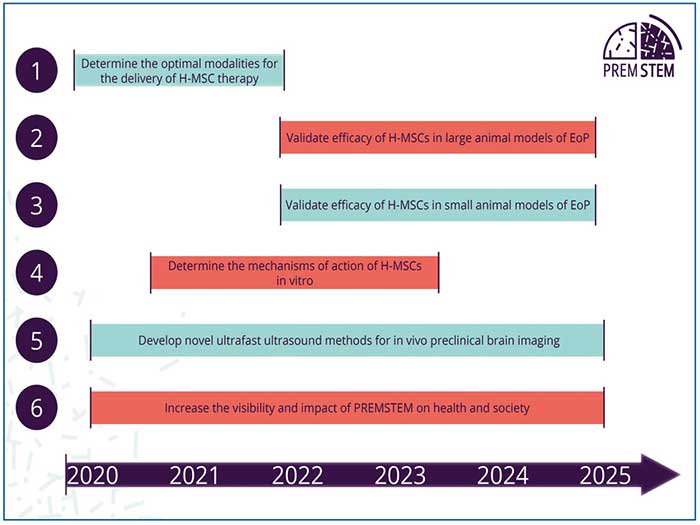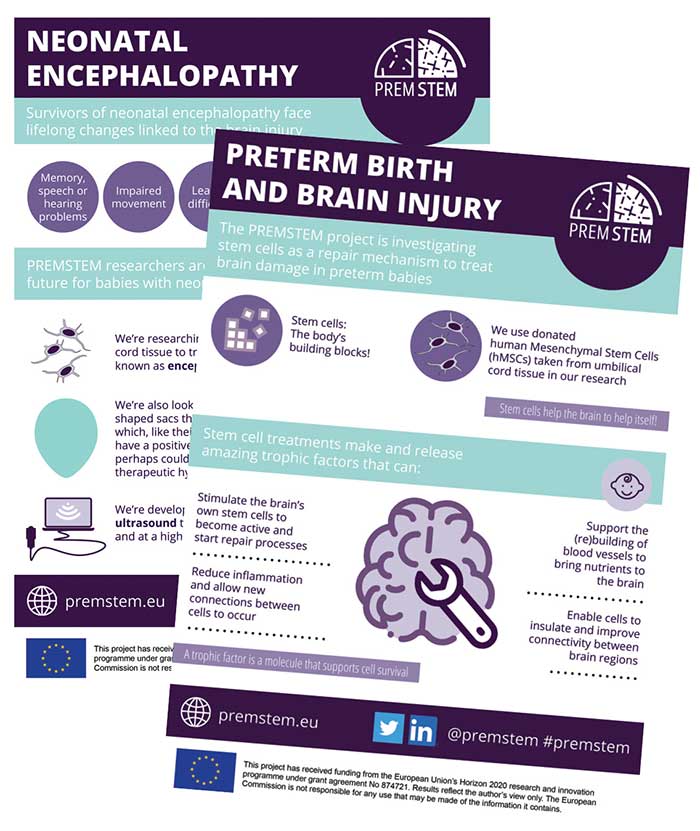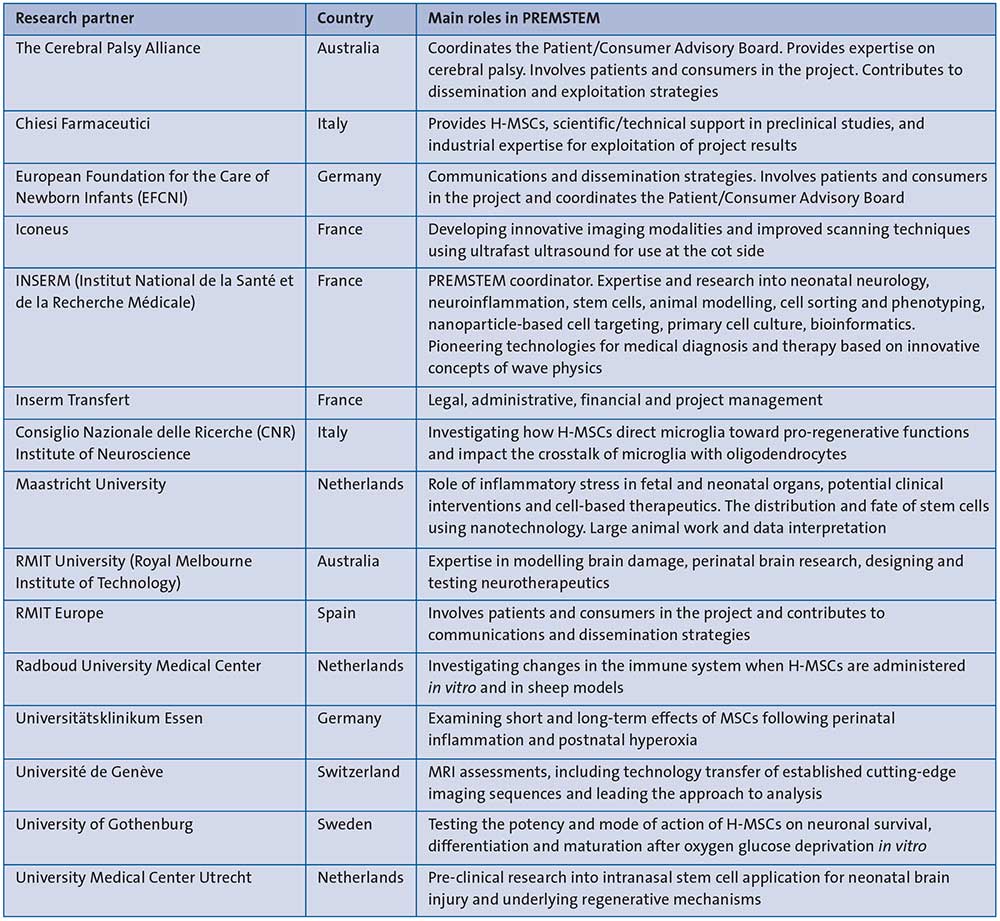PREMSTEM: pushing forward the research agenda for neonatal innovation
Hannah Tribe
Research Communications Advisor, RMIT Europe
hannah.tribe@rmit.edu.au
Bobbi Fleiss
Head of Perinatal Brain Injury Laboratory,
RMIT Australia
PREMSTEM, the brain injury in the premature born infant: stem cell regeneration research network, is a collective of researchers from across the globe developing a new regenerative stem cell therapy to repair the brain damage caused by premature birth, also known as encephalopathy of prematurity (EoP). The project has received €9 million funding from the European Union’s Horizon 2020 research and innovation programme to push forward the research agenda for neonatal innovation by bringing together a committed interdisciplinary partnership to provide a road-map for how medicines can be optimised for use in this understudied patient group.
The PREMSTEM team comprises world leading clinicians, researchers, stakeholder advocacy groups and an industrial partner with well-established experience in neonatology and drug development (TABLE 1). The 15 research partners represent eight countries with vast experience in:
- perinatal brain injury
- driving innovative and high-quality research
- designing novel technological solutions to clinical needs
- engaging stakeholders in the design, implementation and outcomes of research
- navigating the complex regulatory frameworks for designing a neonatal therapy.
TABLE 1The PREMSTEM research partners.
The aim of PREMSTEM
Advances in perinatal medicine, especially in respiratory support, mean that even the sickest and smallest babies with EoP often survive, but there are currently no treatments to repair the damage to the brain. PREMSTEM is focused on delivering to the clinic a novel regenerative therapy to reduce the enormous emotional, health and economic implications of neuro-developmental injury caused by EoP. The mission is to validate umbilical cord derived human mesenchymal stem cells (H-MSC) as a regenerative therapy for EoP to improve the quality of life for preterm infants and reduce the societal costs of their special needs.
The aim is to progress H-MSCs for EoP through early and late-stage preclinical research while preparing the regulatory approvals for phase I and II clinical trials. It is envisaged that within five years, applications for the H-MSC therapy will extend to other types of perinatal brain injury (eg birth asphyxia in term-born infants), and to disorders such as paediatric multiple sclerosis that share pathophysiological processes with EoP (eg inflammation and demyelination).
Background to the research
In the European Union alone, 400,000 babies are born preterm each year. Many of these babies are at increased risk of neonatal mortality and morbidity, lifelong disability including cerebral palsy, impaired cognitive function and increased rates of neurodevelopmental disorders such as attention deficit and hyperactivity disorder and autism spectrum disorder. The damaging effects of preterm birth on the brain carry significant economic costs, and can have negative impacts on families and communities. As diagnosis of EoP can often only be definitively made days or weeks after birth, the most important strategy for treatment is one that promotes neuroregeneration of the damaged brain.
Research methodology
Substantial clinical evidence supports that H-MSCs are safe for use in babies and children, being applied in a number of studies focused on brain injury specific in type to the term born infant and in children with established neurological disorders. Also, pre-clinical data demonstrate that MSCs are robustly regenerative in several types of neurological injuries, including in models of perinatal brain injury. However, these studies are typically small (one model, one treatment paradigm). PREMSTEM is harnessing research excellence in the field of perinatal medicine to extensively test and characterise the regenerative abilities of various doses, timings and routes of administration of umbilical cord-derived H-MSCs in both small and large animal models of EoP. The following section and FIGURE 1 give an overview of planned activities and expected outcomes.

FIGURE 1 An overview of planned activities and the timeline for the PREMSTEM project.
Delivery modalities: the first step is to determine the best dose, time and delivery route to get a therapeutic effect of H-MSCs in rodent models.
Effects of H-MSC induced-neuroregeneration: the objective is to study short and long-term effects of H-MSC induced-neuroregeneration, especially on motor behaviour and cognitive function, using large animal models that capture important hallmarks of the human pathology.
Therapeutic effects of H-MSCs:gathering more knowledge about the therapeutic effects of H-MSCs on neuronal and vascular development, inflammatory responses and cellular metabolism using multiple clinically relevant rat models of EoP.
Mechanisms of action: understanding the mechanisms of action of H-MSCs at the molecular and cellular level is crucial to determining which babies with EoP will most benefit from H-MSC therapy.
Technological innovation: developing new, inexpensive and easy to use imaging tools that will improve our ability to understand the underlying pathophysiology of brain injury in preterm born infants. The enhanced detail and higher resolution provided by ultrafast ultrasound will aid the diagnosis of brain injury at the cot side.
Research into practice: bringing research into improved human health outcomes is the major objective. Engaging key stakeholders (patients/consumers representatives, clinicians and caregivers, scientific community, policy makers, the general public) and consulting them on experimental design and implementation is a crucial step to fast track the use of H-MSCs to bedside clinical research.
Patient/consumer advisory board
As the PREMSTEM project has the potential to have a big impact on society, it is important to make sure that research progress and findings are communicated to as many interested people as possible. To help make this happen, an independent consultative group of patient and consumer representatives has been established. Coordinated by the Cerebral Palsy Alliance and the European Foundation for the Care of Newborn Infants (EFCNI), the Patient/Consumer Advisory Board (PCAB) members:
- offer unique perspectives, input and recommendations
- provide feedback and comments on the content and design of our communications materials
- contribute to the PREMSTEM exploitation strategy, which outlines the project’s steps towards clinical trials
- ensure that the voices of those born preterm and their family members and carers are heard and considered
- provide a forum for representatives to raise concerns or ask
questions with the PREMSTEM team.
Co-creation and the PREMSTEM project
Co-creation and design thinking methodologies are included in the project as part of PREMSTEM’s objective to consistently engage and consult key external stakeholders as it paves the way towards clinical trial of the H-MSC therapy. Helping the research partners to see beyond their own perspectives, co-creation activities allow participants to provide feedback, describe experiences and offer ideas and inputs about the research, thereby revealing insights from people representing those who might one day use or benefit from it. PREMSTEM’s co-creation activities include online co-creation workshops that take place approximately once a month with participants representing key stakeholders, including parents of children born preterm and clinicians. One-on-one interviews via telephone or video call are also conducted in order to share individual and deeper insights. PREMSTEM partner RMIT Europe coordinates the co-creation activities.
Providing hope for babies with EoP
The long-term aim of PREMSTEM is to take the stem cell therapy for preterm brain injury to clinical trial; the lessons learnt and knowledge accrued along the way will offer a brighter future for preterm infants and their families. PREMSTEM provides a unique opportunity to have engaged stakeholder, clinical and industry support, assuring research will be translated into effective clinical trials.
The PREMSTEM website (www.premstem.eu) houses a large number of resources – news, publications, factsheets (FIGURE 2) and videos – suitable for families and healthcare professionals.

FIGURE 2 PREMSTEM factsheets.
Or read this article in our
Tablet/iPad edition



